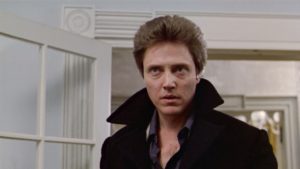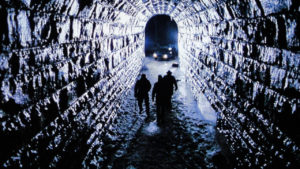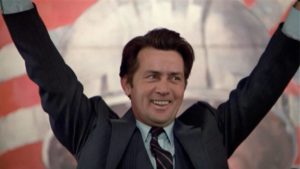Attend: Program Notes
The Dead Zone | David Cronenberg | United States | 1983 | 103 min.
Cinesthesia, Madison Public Library Central Branch, Thursday, November 1, 6:30 p.m.»
A successful fusion of two extremely different artistic visions, David Cronenberg’s overlooked adaptation of Stephen King’s novel The Dead Zone has become scarier than ever, in view of the contemporary political climate.
“Because of our necessity to impose our own structure of perception on things we look on ourselves as being relatively stable. But, in fact, when I look at a person I see this maelstrom of organic, chemical and electron chaos; volatility and instability, shimmering; and the ability to change and transform and transmute.” — David Cronenberg, in a 1989 interview with filmmaker Bette Gordon for BOMB Magazine
 An existential science-fiction horror thriller from 35 years ago that has become improbably relevant in view of recent events, The Dead Zone stars Chrisopher Walken as a schoolteacher named Johnny Smith who awakens from a five-year coma to discover that he has acquired the gift of extrasensory perception. He soon realizes that he can not only predict the future, but he also has the power to change it. When Smith encounters an unhinged right-wing populist demagogue campaigning for political office and suddenly foresees an imminent apocalyptic scenario, he must make an extremely important decision.
An existential science-fiction horror thriller from 35 years ago that has become improbably relevant in view of recent events, The Dead Zone stars Chrisopher Walken as a schoolteacher named Johnny Smith who awakens from a five-year coma to discover that he has acquired the gift of extrasensory perception. He soon realizes that he can not only predict the future, but he also has the power to change it. When Smith encounters an unhinged right-wing populist demagogue campaigning for political office and suddenly foresees an imminent apocalyptic scenario, he must make an extremely important decision.
Director David Cronenberg’s impressive adaptation of Stephen King’s eerily prophetic 1979 novel of the same name might seem like an outlier among the marginal films of the Canadian body horror specialist. One of his most mainstream works, The Dead Zone represents a collaboration between someone who undoubtedly remains the single most commercially successful writer in the history of horror literature and a controversial auteur who seems to pride himself on the provocative, disturbing, and emphatically non-commercial nature of his creations. While Cronenberg eschews, for the most part, the shocking surrealistic flourishes that distinguish his other films, his usual thematic preoccupations are still intact. Like all of his movies, The Dead Zone unflinchingly explores the intensity of human frailty and decay with a focus on the body and its many accelerated mutations, whether out of disease, anger, dread, or hope.
Although the metamorphosis of Johnny Smith may not be perceivable by normal sensory channels, Cronenberg’s wasted hero undergoes a transformation no less radical than that of, say, Seth Brundle in The Fly (1986), which features Jeff Goldblum as a brilliant, eccentric scientist whose teleportation experiment goes dreadfully awry. As Smith struggles with the terrible responsibility of his newfound psychic powers, he becomes increasingly alienated and withdraws further into an insular, hermetically sealed world that only he can access. Faced with a life devoid of meaning, he ultimately has no choice but to use his potential for the benefit of humanity, even if that entails sacrificing himself in the process.
Cronenberg strips down King’s source material to its bare essence, using the book as a springboard for a tale about the human condition and the decisions we make to give our fleeting lives purpose. He keeps the audience at a contemplative distance as he suggestively portrays Smith’s deterioration and the emptiness of his isolated existence. The story comes to life because the characters are vividly three-dimensional and the performances are uniformly excellent, thus facilitating our suspension of disbelief. Shot in Ontario, Canada, where temperatures plummeted past freezing, The Dead Zone unfolds amid a desolate, wintry landscape that heightens the film’s chilly atmosphere, along with Cronenberg’s clinical detachment, Michael Kamen’s sadly pensive score, and Jeffrey Boam’s episodic, well-paced screenplay.
After Videodrome (1982), an apocalyptic techno-surrealist horror film about how electronic media alters its users, Cronenberg was evidently looking for a tonal change from his previous work’s lurid descent into an underworld of fascist conspiracies, sadomasochistic sex games, and extreme body modification. “Videodrome was a very heavy experience,” the director reveals in the book Cronenberg on Cronenberg. “If you’re used to comedy, The Dead Zone is a very heavy picture. But if you’re used to Videodrome, Dead Zone is not. At that point I needed to do something based on somebody else’s work, as a relief.”
The Dead Zone was optioned shortly after its publication in 1979, and several screenwriters and directors were involved in its production before Cronenberg took over the project in 1982. Stanley Donen (Singin’ in the Rain), John Badham (Saturday Night Fever), and Michael Cimino (Heaven’s Gate) were once attached to direct, while Stephen King attempted to write a draft of the screenplay himself.
“King’s own script was terrible,” Cronenberg later said. “It was not only bad as a script, it was the kind of script that his fans would have torn me apart for doing […] It was basically a really ugly, unpleasant slasher script. The Castle Rock Killer in the middle of the movie becomes the lead, and it was, ‘Let’s show lots of his victims.’” Jeffrey Boam concurred, stating that King had “missed the point of his own book.”
In the process of adaptation, Cronenberg and Boam greatly streamlined King’s long and complex novel. The narrative switches between Smith and Greg Stillson were removed and the story was told entirely from the protagonist’s point of view. Although violence remains in the movie, Cronenberg depicts it less graphically than the book and omits King’s excesses. For instance, Stillson no longer kicks a dog to death.
The story was simplified further in the final edit. Cronenberg had originally filmed a pre-credits scene in which Smith suffers a head injury while ice-skating as a young boy, therefore implying the origin of his clairvoyance. He eventually cut this out, leaving only the vague suggestion that Smith already had some sort of latent ability before his accident when he feels a sharp head pain while riding on a roller coaster.
Before filming began, various names were tossed around for the lead role. Curiously, King wanted Bill Murray. Cronenberg was concerned that Walken might be too old to play the part, and his original choice was his frequent collaborator Nicholas Campbell, who instead played the deputy sheriff Frank Dodd. He later admitted that Walken was not only right for the role, but also the film’s enduring image.
Walken, of course, dominates the film with his halting verbal rhythms, glassy stare, and wan, haunted expression full of pathos, fragility, and wistful longing. “It’s Chris Walken’s face,” Cronenberg has said. “That’s the subject of the movie; that’s what the movie was about. All the things that are in his face.”
 At once a brooding, hypnotic, and starkly beautiful character study, a poignant reflection on the centrality of choice to humanity’s search for meaning, a straightforward, accessible genre picture, and an alarmingly prescient political fable, The Dead Zone stands as one of the strongest adaptations of King’s works. It also ranks among Cronenberg’s most fascinating creative experiments. The film finds the director at the height of artistic restraint, while disguising his unorthodox vision in King’s pop sensibility.
At once a brooding, hypnotic, and starkly beautiful character study, a poignant reflection on the centrality of choice to humanity’s search for meaning, a straightforward, accessible genre picture, and an alarmingly prescient political fable, The Dead Zone stands as one of the strongest adaptations of King’s works. It also ranks among Cronenberg’s most fascinating creative experiments. The film finds the director at the height of artistic restraint, while disguising his unorthodox vision in King’s pop sensibility.
Even though critics gave The Dead Zone some of the most positive reviews of Cronenberg’s career at that point, the movie finally did not have the same cultural impact as other adaptations of King’s works. The Dead Zone earned approximately $20 million on a budget of $10 million, but it was not a hit like Brian De Palma’s sensationally violent Carrie (1976), for example, and it only made about as much money as Lewis Teague’s insipid adaptation of Cujo or John Carpenter’s version of Christine (1983).